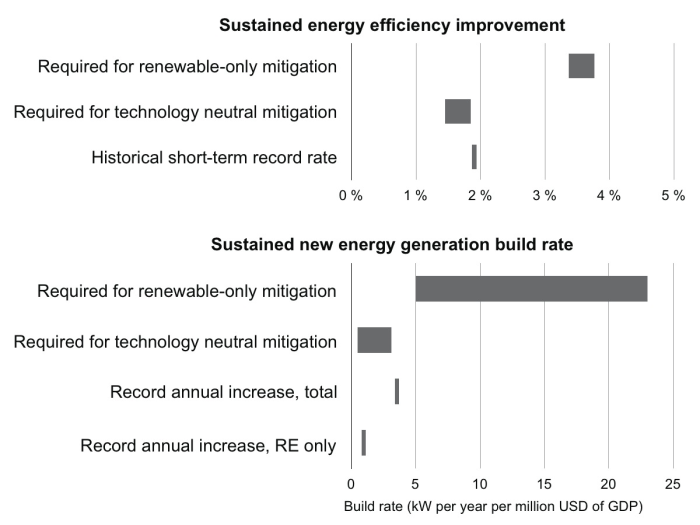
In the previous two posts, we showed with IPCC data how the climate mitigation scenarios proffered by anti-nuclear groups are based on extreme optimism on not just one but two counts: they assume that renewables will grow at least as fast as, and that energy demand increase can be checked at least as well, as the most optimistic IPCC projections allow. Generally speaking, if the plan depends on not just one but two factors developing according to the most optimistic assumptions, one might want to have a different plan – especially if at the stake is the future of our only habitable planet.
But how much are these plans assuming, in fact? This important question is partially answered in a recent study by Loftus et al. (2015), which examined 17 widely publicized global decarbonization scenarios. These included three scenarios (from World Watch, Greenpeace, and Stanford professor Mark Jacobson et al.) that explicitly attempted to stabilize the climate without nuclear energy – relying solely on energy efficiency, renewables, and fossil fuels.
The key results are summarized to the graphic above, and compared to short term, historically achieved records (that is, the best single year ever). For renewable only scenarios, energy efficiency needs to improve every year almost twice as fast as has been achieved in the best year in record. Simultaneously, new (renewable) energy generation must be built 1.4 to 15 times (!) faster than new energy generation from all sources together has been ever added in a single year – and this build rate must be sustained for decades.
Succeeding in either one of these alone would be a monumental undertaking. Succeeding at the both at the same time may be technically possible, but it is most certainly a gamble – a Climate Gamble.
This series of posts introduces graphics from our book Climate Gamble: Is Anti-Nuclear Activism Endangering Our Future? The book is now available on Amazon.com in Kindle and paperback formats; see also our crowdfunding initiative which aims to deliver a copy of the book to COP21 climate delegates in Paris this December.
References
Loftus, P. J., Cohen, A. M., Long, J. C. S., & Jenkins, J. D. (2015). A critical review of global decarbonization scenarios: what do they tell us about feasibility? Wiley Interdisciplinary Reviews: Climate Change, 6(1), 93–112. doi:10.1002/wcc.324
Reblogged this on A Public Eye on Energy.
LikeLike
[…] previous weekly pic introduced the calculations of Loftus et al. (2015), which show that decarbonization scenarios that […]
LikeLike
[…] even went as far as to propose coal as an alternative to nuclear power) despite clear and mounting evidence that they were inadequate for the challenges of the […]
LikeLike